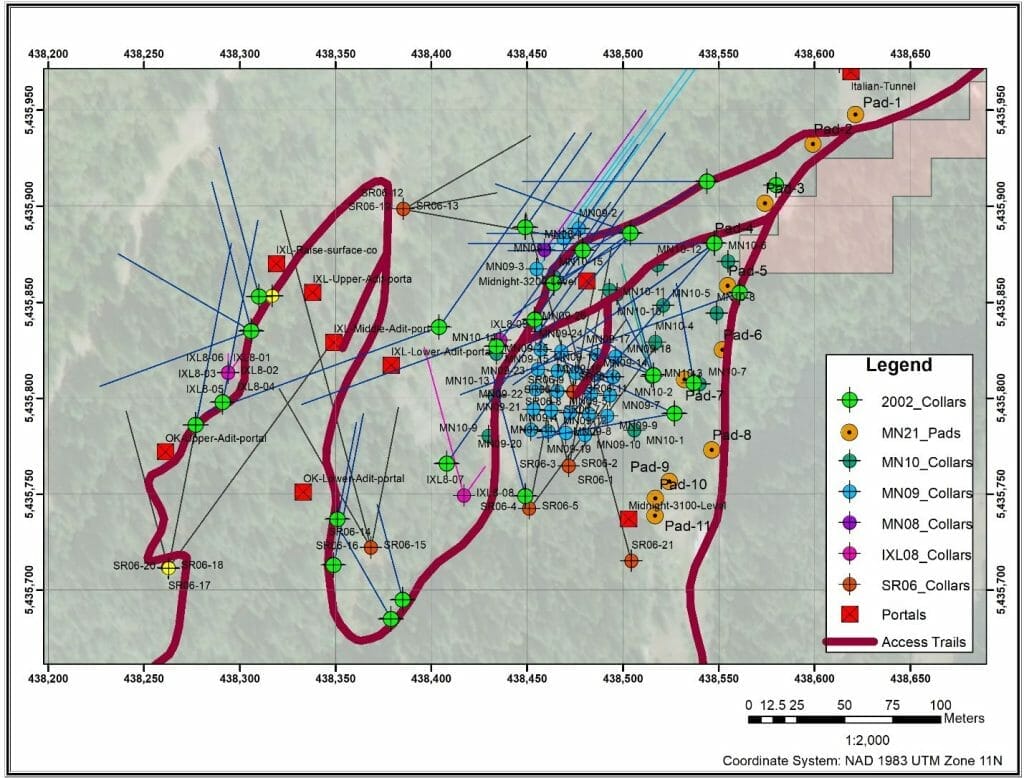MIDNIGHT PROJECT
History
The Rossland district is located in southeastern British Columbia, Canada, and is the second largest gold producing camp in the province. The camp is one of British Columbia’s major gold mining districts with over 3 million ounces (85,000 kilograms) of gold and 3.5 million ounces (100,000 kilograms) of silver produced between 1899 and 1928 from the Le Roi, Center Star, Josie, War Eagle and other mines in the Main belt. Total historical district production has been about 6.2 million tons at an average grade of 14.1 gpt gold (Au) and 18 gpt silver (Ag) and 1.1% copper (Cu.)
Within the western part of the Rossland Camp is the Midnight Mine area on the east facing slope of OK Mountain. This area has produced approximately 30,000 ounces of gold from narrow, extremely high-grade quartz veins with free gold that grade 1-5 oz/t Au, and average nearly 3 oz/t.
West High Yield (W.H.Y.) Resources Ltd. has purchased 8 mineral titles covering approximately 85 hectares and staked additional adjacent favourable ground covering approximately 2,348 hectares. The claims occur in the valley of Little Sheep Creek, in a north trending, kilometer wide wedge that is bounded by to east by the Jumbo fault and to the west by the OK fault, and parts of OK mountain and Record ridge nearby.
The IXL, Midnight and OK claims together produced approximately 30,000 ounces of gold from 11,000 tons of ore (approx. 3 oz/t) between 1895 and 1964. Between 1965 and 1970, considerable underground work and diamond drilling was completed by Cinola Mines, Tull Mines, and others. At one time a 70 tpd gravity mill was set up on the Midnight claim, but this mill was later taken down. Tull mined approximately 950 tons of ore grading between 0.3 and 1.5 oz/t Au from veins and the ore was processed at the Cominco smelter in Trail. Subsequently, several small shipments (10-30 tons) of ore have been extracted from veins in the Midnight and IXL mines, by Allan Matovich and by lessors and shipped to various mills and smelters for processing. Much of this work was done on a zone within the Midnight mine named the Baker vein or zone.
During 1993-1994, Consolidated Ramrod Gold Corp. optioned the properties from Al Matovich and drilled 12 surface diamond drill holes targeting zones of auriferous carbonate alteration and quartz veining in the ultramafic intrusion. Intersections in this unit included areas of higher Au grade, such as 0.24 oz/t over 5 meters in hole S-12, and broader areas of low grade, including 48 meters grading 0.051 oz/t Au in hole S-3. Midnight Mining Company Limited optioned the Midnight claim in 1995 and drilled five underground holes in an attempt to outline high grade areas on one of the veins. It is estimated that approximately $2 million has been spent on the claims since 1967 by various operators, much of that in underground development and drilling from surface and from underground.
Rossland Gold Camp History
(Gold Trails & Ghost Towns)

High Potential Gold Exploration
West High Yield Resources’ 2022 Drill Program was completed and closed for the winter season on November 15th at the Company’s Midnight Gold claim (“Midnight”) located in the Rossland Gold Camp area, British Columbia (see Figure 1). The three drills at Midnight demobilized in October and November. A total of 6,197 metres were completed (see Table 2) during the course of the Program. The Rossland Gold Camp historically produced over 2.76 million ounces of recovered gold and 3.52 million ounces of recovered silver.
2022 DRILL PROGRAM HIGHLIGHTS


Figure 2. NQ2 diameter core showing two visible gold occurrences in MN22-13 72.35-72.65m. Gold grains range from <1mm to 4mm as irregular particles and aggregates disseminated or along microfractures mainly in listwanized peridotite (quartz, serpentine and carbonate with Fr-Cr oxide relicts). Gold also was noted with fine to coarse-grained aggregates of brecciated pyrite and dark green chlorite, serpentine and quartz. Field of view approximately 60mm (Left) and 20mm (Right). Assay – 154 g/t Au. SCR-24B coarse fraction 9% of weight, 58 wt.% of the gold.
Table 1. Summary of recent 2022 drill core intersections (MN22-05 to MN22-13 inclusive, MN22-19, MN22-21) with 2 gram-plus Au g/t values. Samples >10 g/t Au were finished using gravimetric analysis and/or screen metallics (highlighted).
Past Production and Drilling Highlights
